Community structure of benthic macroinvertebrates in reclaimed and natural tidal flats of the Yangtze River estuary
Junzeng Xue, Jiqiang Yang, Qiong Wang, Rihard B. Aronson, Huixian Wu
a Ballast Water Detecting Laboratory, Shanghai Ocean University, Shanghai, 201306, China
b Key Laboratory of Exploration and Utilization of Aquatic Genetic Resources, Shanghai Ocean University, Ministry of Education, Shanghai, 201306, China
cDepartment of Ocean Engineering and Marine Sciences, Florida Institute of Technology, Melbourne, FL, 32901, USA
Keywords:Reclamation area Tidal flat Benthic macroinvertebrates Community structure
ABSTRACT Previous studies have found differences between communities of benthic macroinvertebrates living in constructed tidal flats compared with natural ones. We analyzed the distributional characteristics of benthic macroinvertebrates in a blowing sand reclamation area (Area A), a dike-building silting area (Area B), an out-ofsiltation area (Area C), and a natural tidal flat (Area D) in order to characterize the community structure and diversity of benthic macroinvertebrates in a human-disturbed estuarine tidal-flat wetland. A total of 32 benthic macroinvertebrate species were identified (Area A=7; Area B=12; Area C=10; Area D=27). The diversity index was variable where: Area B <Area C <Area A <Area D. A higher average annual abundance of benthic macroinvertebrates was found at Area B (840.43 ± 569.23) ind/m2 than in Area D (203.00 ± 5.85)ind/m2, Area A (42.87 ± 10.21) ind/m2, and Area C (17.64 ± 1.50) ind/m2. The biomass in Area C(3.18 ± 0.39) g/m2 was lower than in the other areas. One-Way ANOVAs detected significant differences(P <0.05) in the abundance and biomass within Area B among seasons; however, there were no significant seasonal differences (P >0.05) in the abundance and biomass of Areas A, C, and D. An abundance/biomass curve showed that the habitat in Areas A,B,and C could be categorized as moderately disturbed,whereas Area D was categorized as undisturbed. The results of cluster analysis suggested distinct assemblages in the four sampling areas. Reclamation raised the altitude of tidal flats, weakening the tidal power and changing the physical and chemical parameters of the water, leading to a change in the community structure of benthic macroinvertebrates.
1. Introduction
Estuaries are important links and transition zones which connect river basins with oceans.Patterns of water mixing are complex in these ecologically fragile environments (Little, Wood, & Elliott, 2016). The Yangtze River estuary is considered to be among the most anthropogenically-impacted regions in China. The coastlines of the Yangtze River estuary are undergoing rapid changes, continuing a long history of tidal-land reclamation.Reclamation refers to the human influence of building dams in tidal flats,accelerating sediment deposition during the ebb and flow of the tide.In order to speed up the rate of land formation,some reclamation areas may also involve artificial blowing measures during reclamation. Estuarine habitats are a key target of reclamation in Shanghai,where reclamation is considered the primary solution to an increased need for land for economic development (Lv et al., 2007).Tidal-land reclamation in the Yangtze River estuary will continue to be the major approach for development projects for the foreseeable future.
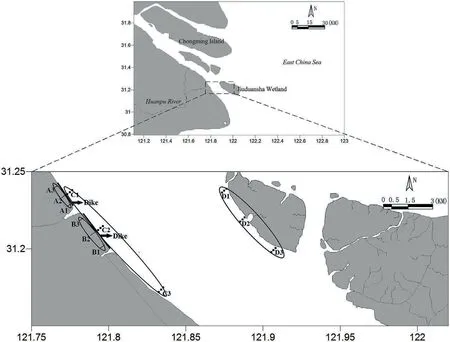
Fig.1. Location of the study areas.Area A:the blowing-sand reclamation area;Area B:the dike-building siltation area;Area C:the out-of siltation area;Area D:the natural tidal flat.
In recent years, increased attention has been paid to the ecological problems caused by reclamation activities (Bo, Wu, Yang, & Zhou,2016; Martínantón et al., 2016; Xu, Cai, Sun, & Tan, 2017). Although reclamation has yielded a vast area of arable land, it has caused to a decline in coastal and intertidal ecosystems and is typically associated with short- and long-term impacts on benthic macroinvertebrates,water, and fisheries (Sato, Yamashita, & Kim, 2007; Yang et al., 2011;Naser, 2011; Marmoush, 1999; Airoldi & Beck, 2007). Benthic macroinvertebrates are important components of estuarine wetland ecosystems, in terms of both energy flow and material circulation. They have great significance in ecosystem engineering and function (Stolyarov,2013; Wan et al., 2018). The characteristics of benthic macroinvertebrates, which include poor mobility and sensitivity to environmental change, make good indicators of environmental disruption (Chen, Gao, Liu, Sun, & Kang, 2013; Shi, Min, Ghaffar, Ali, &Cob, 2014). As a result, they are widely used as bio-indicators of environmental impacts from pollution (Naser, 2010) and several sources of stress, including dredging and reclamation activities (French,Robertson, & O'Donnell, 2004). Gjoni, Cozzoli, Rosati, and Basset(2017) also emphasized the value of simple analysis of assemblages of benthic macroinvertebrates in inferring the properties, functionality,and status of estuarine ecosystems. The biodiversity, abundance and biomass of benthic macroinvertebrates have been related to ecosystem function (Barbone, Rosati, Reizopoulou, & Basset, 2012;Basset, Elliott,West, & Wilson, 2013; Ghezzo et al., 2015; Gjoni & Basset, 2018;Reizopoulou et al., 2014; Sigala, Reizopoulou, Basset, & Nicolaidou,2012).
Previous studies in the Yangtze River estuary have indicated that altering the sedimentary environment reduces species richness and diversity(Lu,Goh,&Chou,2002;Ma et al.,2011,2012;Wang,Liu,Xu,&Yu, 2001; Yuan & Lu, 2001a, 2001b). The species composition of benthic macroinvertebrate assemblages has exhibited distinct differences between constructed and natural tidal flats(Evans,Ward,Bone,&Leakey, 1999). Macroinvertebrate assemblages exhibited differences among a terrestrial area, a siltation area, and a natural tidal flat. Dams in silting tidal flats differentiated tidal-flat habitats (Yang, Zheng,Wang, Xue, & Wu, 2016), forming two types of habitats: in-siltation areas and out-of-siltation areas, which both differed from the natural tidal flats. Within the in-siltation areas, different modes of siltation led to further habitat differentiation:dike-building siltation areas(with the effect of dams to weaken the tides, siltation is increased) and sandblowing reclamation areas(based on dike-building siltation,siltation is further accelerated artificially by hydraulic mud-fill).
Those previous studies have focused primarily on the period occurring after the completion of the reclamation(French et al.,2004;Lu et al., 2002; Lv et al., 2012). However, research is rare for the period during which reclamation is in progress.Furthermore,the structures of macroinvertebrate benthic assemblages have not been compared between natural tidal flats, out-of-siltation areas, blowing-sand reclamation areas, and dike-building areas. We compared the assemblage structures of benthic macroinvertebrates among the four habitat types to elaborate upon the varying degrees of impact on community structure caused by reclamation. We elucidated the benthic assemblage composition in different reclamation areas during reclamation, attempting to provide reference data for exploring succession in benthic macroinvertebrate assemblages under reclamation regimes, compared with the natural state. Our findings provide a rationale for protecting benthic macroinvertebrates and wetlands within the estuary and highlight the need for the remediation and reconstruction of damaged tidal flats to their natural state.
2. Materials and methods
2.1. Study site
This study took place on the tidal-flat silting zone outside Pudong airport on the south bank of the Yangtze River estuary(31°07′01.88″N- 31°15′34.49″ N, 121°44′38.28″ E - 121°51′33.66″ E). The site was chosen because it is affected by semidiurnal, shallow-sea tides and is located in the convergence zone of fresh and salt water in the Yangtze River estuary. Engineering projects, carried out since 2007, have divided the site into three reclaimed areas. Two projects were still in the siltation stage and the third was completely transformed into terrestrial habitat. The total area is 250 ha, the average tidal range is 2.4-3.3 m,and the total length of the dike is about 6 km.The natural tidal flats are a nature reserve that lies across the river from the reclaimed areas.
2.2. Sample collection and statistical analysis
Field sampling occurred on 20 October 2014 (autumn), 22 January 2015 (winter), 22 April 2015 (spring), and 23 July 2015 (summer).Twelve stations were sampled(Fig. 1):three blowing sand reclamation areas in Area A; three stations in Area B, the dike-building siltation area;three out of siltation area in Area C;and three sections in Area D,the natural tidal flat.Three replicate samples were taken at each station per season.
Quantitative sampling was carried out using a sampling frame(25 cm×25 cm×30 cm) and a clamshell bottom-sampler with a sampling area of 0.1 m2. Data from samples were obtained using two sampling methods.Samples were sieved in situ through a 0.5-mm mesh using seawater and fixed in 5% formalin. The collected benthic macroinvertebrates were sorted, counted, and weighed in the laboratory.Additional specimens were used for species identification, if required.Prior to collection, salinity, pH, dissolved oxygen, and temperature were measured in-situ with a WTW Multi 3430, and turbidity was measured with a turbidimeter. NH4-N, NO3-N, NO2-N, TN, and TP were analyzed by spectrophotometry (Qiu, Zhao, & Sun, 2012).
Cluster analysis was performed using the Bray-Curtis index on square-root-transformed data. Ordination diagrams of canonical correspondence analyses (CCA) were used to evaluate the relationships between sampling sites and environmental conditions. Biological indices such as the Shannon-Wiener diversity index (H’), Margalef's species-richness index (d), and Pielou's evenness index (J) were also calculated and compared. The analyses were conducted using the Primer V6.1.6 software package (Clarke & Ainsworth, 1993). Abundance/biomass curves (ABC curves) were used to evaluate the magnitude of disturbance caused by reclamation (Warwick, Clarke, Gee, & Green,1988). One-way ANOVA designs were employed to compare the abundance and biomass of benthic macroinvertebrates between the different sampling sites. The relative abundances (RA) of each species were estimated as the percentage of individuals of a particular species out of the total number of individuals of all combined species. The occurrence rate (OR) was calculated as the number of times that a particular species was present divided by the total number of sampling events. RA and OR values were expressed as percentages.
3. Results
3.1. Environmental conditions in the study areas
The average water temperature across sampling areas was 18.11 ± 0.13°C. Water temperatures ranged from 8.3°C (site D1,winter) to 27.8°C (site B2, summer). The average pH of all sampling areas was 7.87 and there were no significant differences among seasons.
There were significant differences in both water depth and turbidity(ANOVA,P <0.05).The water depth of Areas A and B ranged from 0.2 to 0.3 m; from 2.5 to 2.7 m in Area C; and from 0.8 to 1.0 m in Area D.One-Way ANOVA showed that the depths in Area C were significantly greater than in Areas A, B, and D (P <0.05). The waves in Area C struck the edge of Areas A and B, resulting in significantly higher turbidity than in the other areas (Fig. 2).
There were no significant differences in the chemical parameters of water taken from the four sampling areas (P >0.05). The average salinity of all sampling areas was 2.24 ± 0.06.The salinity was lowest in Area B and highest in Area D.The NH4-N,NO3-N,NO2-N,TN,and TP concentrations in Area A and were slightly higher than in Areas C and D. This is likely to be related to N and P inputs from reclamation project disturbances.
3.2. Species composition, abundance, biomass, and biodiversity
In general, the four sampling areas were dominated by the Arthropoda, Mollusca, Annelida, and Nemertea phyla, which were found in different proportions for each area in different seasons.
Corbicula fluminea, Stenothyra glabra, Iiyoplax deschampsi, and Tylorrhynchus heterochaetus were dominant species in the area overall,with dominance of 42.3%, 17.5%, 10.3%, and 8.2%, respectively. The Arthropoda accounted for the highest percentage of macrofauna in Areas A and B, which was above 40% in each season in Area A. The highest percentage (44.44%) of Arthropoda of all sampling areas occurred in the summer in Area B. A smaller percentage of Arthropoda was found in Area C,with none found during summer or autumn in this area. The highest percentage of Annelida was found in area C (Fig. 3).Molluscs were most abundant in Area D and included Glaucomya chinensis, Potamocorbula ustulata, and Potamocorbula amurensis, which were found only in this area (Fig. 4; Table 1).
The annual abundance of benthic macroinvertebrates in Area B(840.43 ± 569.23)ind/m2was significantly higher(P <0.05)than in Area A (42.87 ± 10.21 ind/m2) compared to Area C (17.64 ± 1.50 ind/m2) and Area D (203.00 ± 5.85 ind/m2). The abundance of benthic macroinvertebrates in summer was highest in Area B(1594.22 ± 288.90 ind/m2) compared to C (21.52 ± 1.64 ind/m2)and D (247.62 ± 7.74 ind/m2). However, the abundance in autumn was highest in Area A (48.59 ± 7.65 ind/m2) and the abundance at each area was lowest in winter.In each season,abundance decreased in the order: Area B >Area D >Area A >Area C (Fig. 4). The distribution of benthic macroinvertebrate biomass mirrored that of abundance. The average annual biomass (Fig. 4) of benthic macroinvertebrates in Area B (135.25 ± 63.99 g/m2) was significantly higher (P <0.01) than Area A (40.82 ± 16.84 g/m2), Area C(3.18 ± 0.39 g/m2),and Area D(22.79 ± 0.80 g/m2).The biomass in Area C was less than in the other areas, due to the low number of species and small mass of the individuals. A One-Way ANOVA also indicated that there were significant differences in the abundance and biomass at Area B among seasons (P <0.05).However, there were no significant differences in the abundance and biomasses at Areas A, C,and D among seasons (P >0.05). Moreover, high abundance and biomass in every season in Area B was associated with low diversity,richness, and evenness relative to the other areas. In general, the diversity index increased slightly in the order: Area B <Area C <Area A <Area D and the evenness index showed little difference between the different areas (Table 2).
3.3. Analysis of community structure
Cluster analysis, based on Bray-Curtis similarities, was used to characterize the communities in each area and separate the sites into groups (Fig. 5).Areas A,B,C, and D were distinct from each other at a similarity-level of 45%.The results of cluster-analyses were assessed by ANOSIM test, which showed significant differences between the four groups (Global R=0.854, P=0.001).
A total of 32 benthic macroinvertebrate species were observed in the sampling areas(Table 1).RA generally reflected the contribution of the species to the species composition of the area. The top three dominant species in Area A were Diptera larvae(RA 27.50),the bivalve C. flumine (31.25), and the decapod crustacean I. deschampsi (17.66).Insects accounted for a large proportion of the macrofauna. The two most dominant species in Area B were C. flumine (RA 84.35) and I.deschampsi(5.58),and their cumulative RA was as high as 89.93%.The three most dominant species in Area C were C. flumine (RA 53.50),Notomastus sinosus (17.00), and T. heterochaetosus (14.00). The abundance of benthic macroinvertebrates in this area was generally low.Species richness was high in Area D and the number of dominant species (n=9) was greater than in other areas. The cumulative RA was 82.58%, which showed a different composition of benthic macroinvertebrates species compared to tidal flats under human disturbance.Overall, C. flumine was the most dominant species, but was found in different proportions in each area.
The intersections of abundance curves with the biomass curves indicate that Areas A, B, and C can be categorized as moderately disturbed (Fig. 6). The lack of an intersection for Area D suggests that the natural tidal flat could be categorized as an undisturbed area.
3.4. Environmental factors
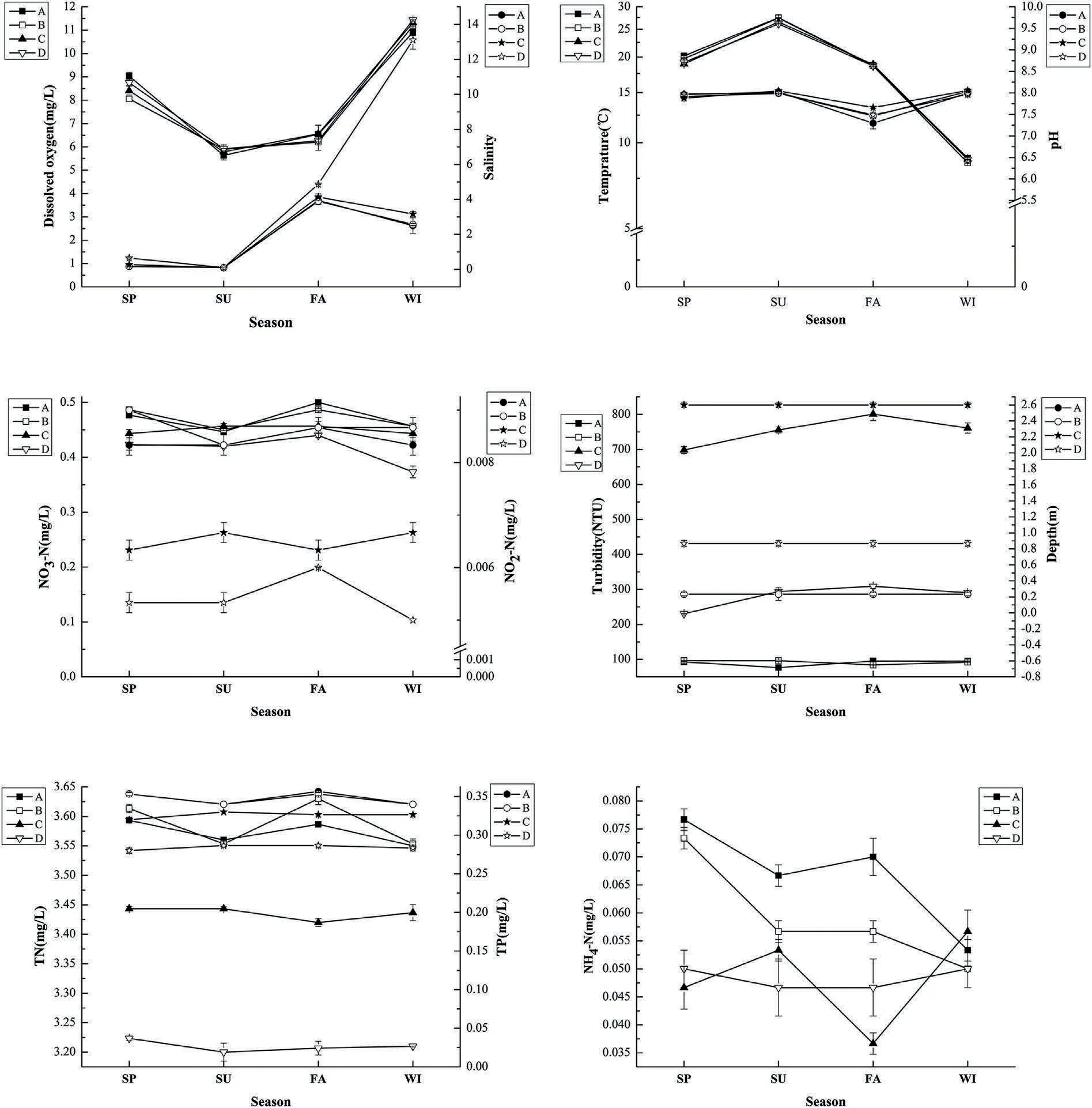
Fig. 2. Environmental parameters in Areas A, B, C, and D during different seasons.
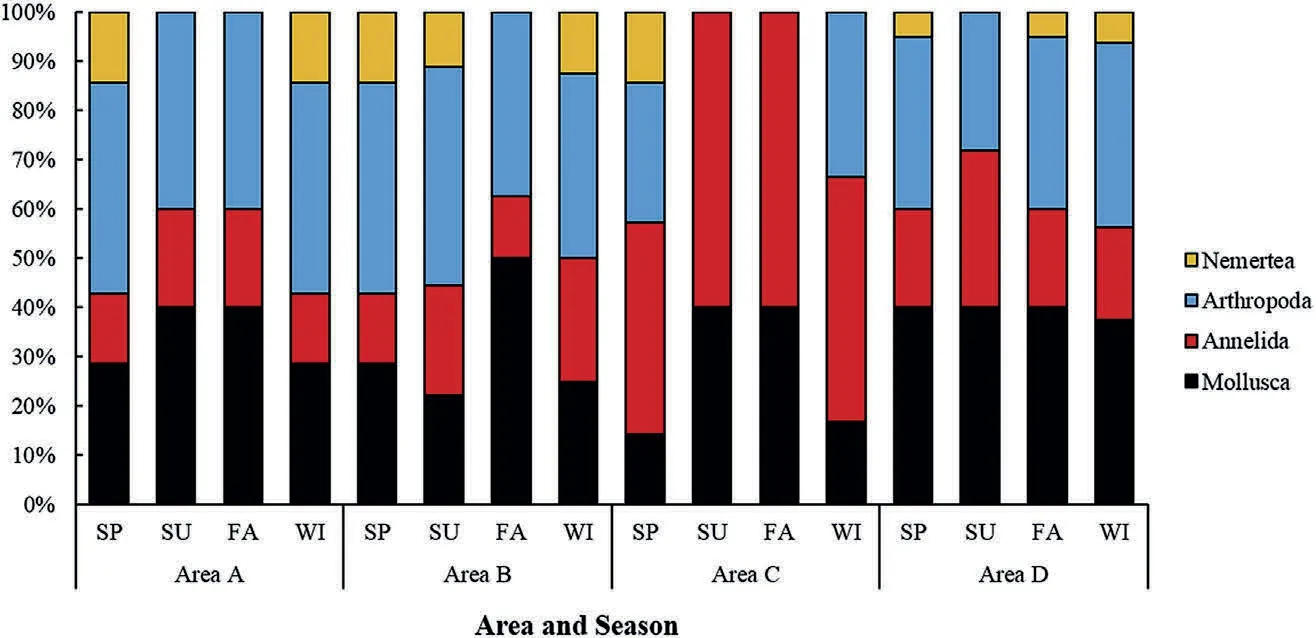
Fig. 3. Proportions of the four dominant taxa of benthic macroinvertebrates in the four areas for different seasons.
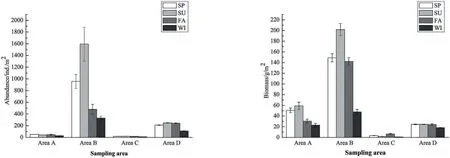
Fig. 4. Abundance and biomass of benthic macroinvertebrates in different seasons within different sampling areas.
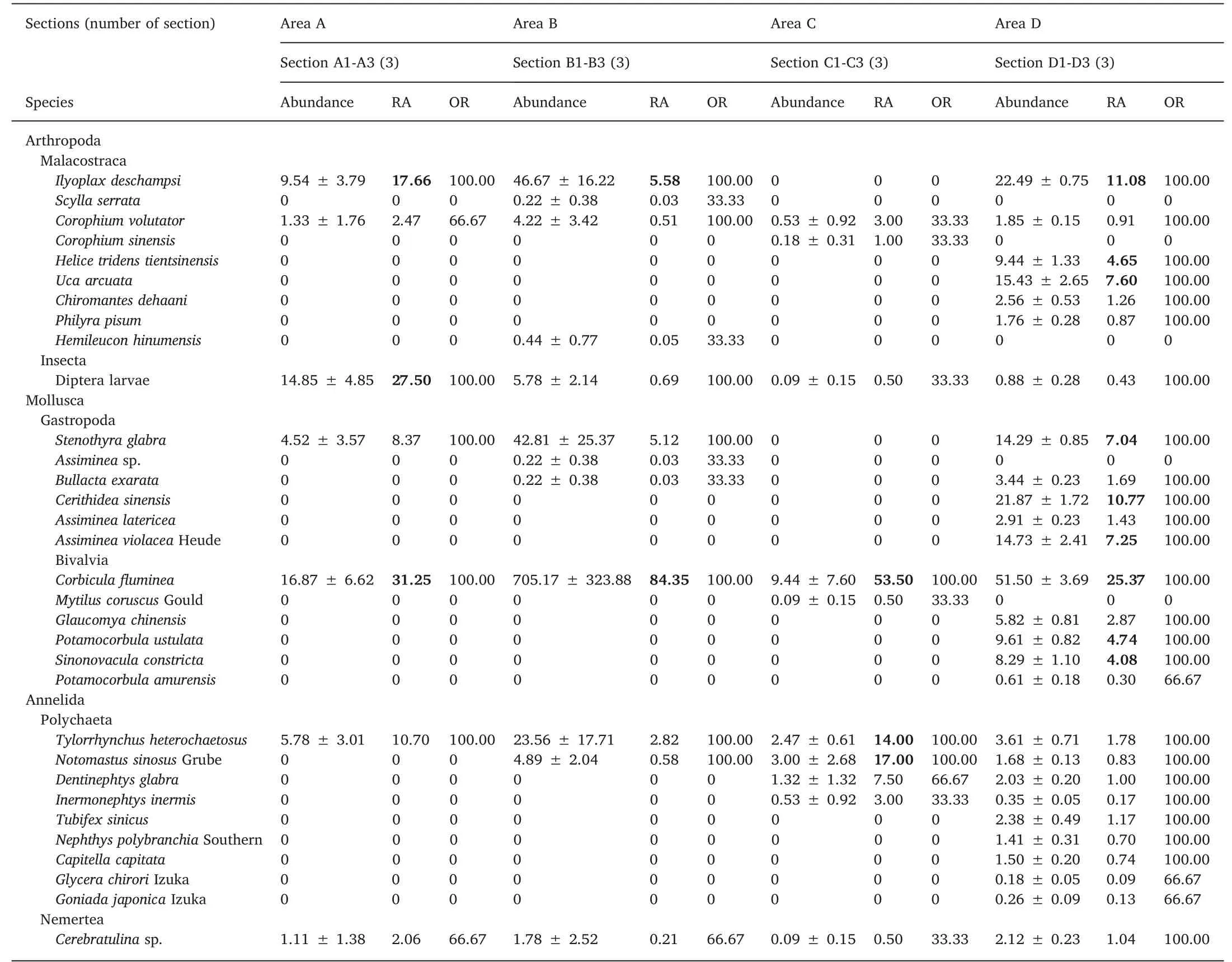
Table 1 Mean abundance(mean ± SD,ind./m2),relative abundance(RA,%),and occurrence ratio(OR,%)of benthic macroinvertebrates species in four sampling areas in October 2014 and January, April and July 2015. Bold values represent dominant species.
Ordination diagrams, based on canonical correspondence analysis(CCA), were used to evaluate the relationship between each sampling site and environmental conditions(Fig.7).The first two ordination axes accounted for 91.2% of the total variance. For Areas A and B, the sampling area showed a strongly positive relationship with NH4-N,NO3-N, NO2-N, TN, and TP. This was expected, given that N and P were entering the water from the bottom and sides of Areas A and B due to engineering and construction. The samples from Area C exhibited high levels of depth and turbidity,likely due to water colliding with the dike. The samples in Area D, which was more saline than the other areas, showed weak relationships with NH4-N, NO3-N, NO2-N, TN,and TP. This indicates that Area D was less disturbed.
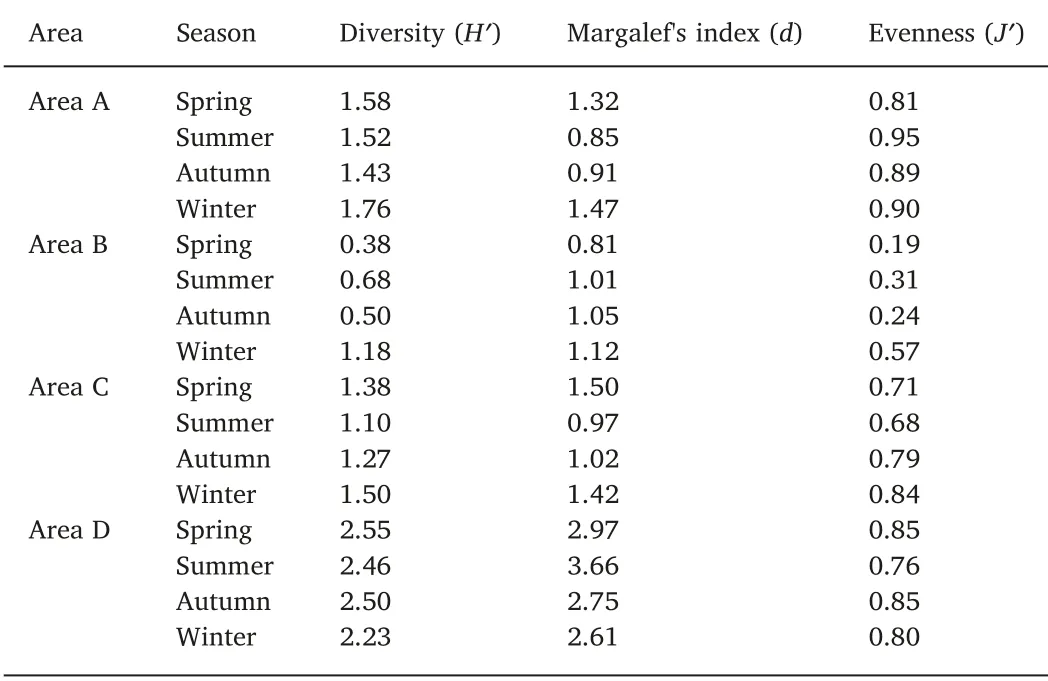
Table 2 Diversity indices of benthic macroinvertebrates in different seasons in different sampling areas.
A second CCA was used to explore the relationships between species and environmental factors (Fig. 8). The first two ordination axes accounted for 92.7%of the total variance.We found the dominant species in Areas A and B, C. flumine and I. deschampsi, showed a strongly positive relationship with nutrients. The results also confirmed that Area A and B were heavily affected by N and P(Fig.7).In addition,dominant species in Area D, Helice tridens tientsinensis, Assiminea violacea, Cerithidea sinensis, Uca arcuate, G. chinensis, P. ustulata and Sinonovacula constricta, exhibited high levels of the important environmental factor salinity: Area D was more saline than the other areas.
4. Discussion
4.1. Community structure of benthic macroinvertebrates
Reclamation engineering changes the tidal flats by speeding up sediment deposition and changing tidal power. These changes affected the species richness, composition, abundance, and biomass of benthic macroinvertebrates (Lui, Lee, & Sadovy, 2002). The seasonal variation in the abundance and biomass was the important factor for the stability of benthic macroinvertebrate community structure(Fang,2013).There was significant seasonal variability in the abundance and biomass in Area B and the high dominance suggested the community structure was unstable. Similar to Areas A and C, Area D did not show seasonal variation in abundance and biomass (P >0.05), though abundance and diversity were higher.The ABC curve corroborated that the assemblage of benthic macroinvertebrates was not disturbed.In general, compared with Area D, which showed the seasonal-variation characteristics of abundance and biomass of benthic macroinvertebrates in natural communities in the absence of human disturbance (Yuan, 2016),Areas A, B, and C exhibited the seasonal-variation characteristics of abundance and biomass in communities under human disturbance.
Multivariate analysis indicated that the four areas represented four distinct types of benthic macroinvertebrate communities.The influence of reclamation in the different parts of the siltation area was varied(Lu et al., 2002). Different approaches to reclamation might also lead to different community structures. Areas A and C were affected relatively seriously, but the degree of influence was different. For Area A, the sand-blowing silting approach rapidly accelerated the rate of sedimentation (Geng & Wang, 2013). Chen (2000) reported that the tidalflat elevation in siltation area studied should rise by 2.7 m in one-half year, resulting in the sharp decline in abundance and species richness(Li, Liu, Zhao, & Guo, 2010). The fact that larvae of Diptera larvae,which are terrestrial/aquatic insects, were so dominant (González,Llanos, & Saldarriaga-Córdoba, 2016) indicated the mortality of intertidal benthic macroinvertebrates and the beginning of terrestrial succession.
In Area C,the construction of the dike had a large impact on benthic macroinvertebrates community (Samuel, Ernest, Gideon, Felix, &Thomas, 2012). The original high- and mid-tidal zones were encircled by the dike engineering and the habitat of the original low-tide zone was changed, resulting in low species richness, abundance, and biomass. Sediment in the area adjacent to the dike will gradually accumulate(Almeida,Neto,Esteves,&Costa,2014).The lack of seasonality may be an important indicator of the gradual evolution of the original low-tide zone to the middle- or high-tide zone influenced by reclamation.
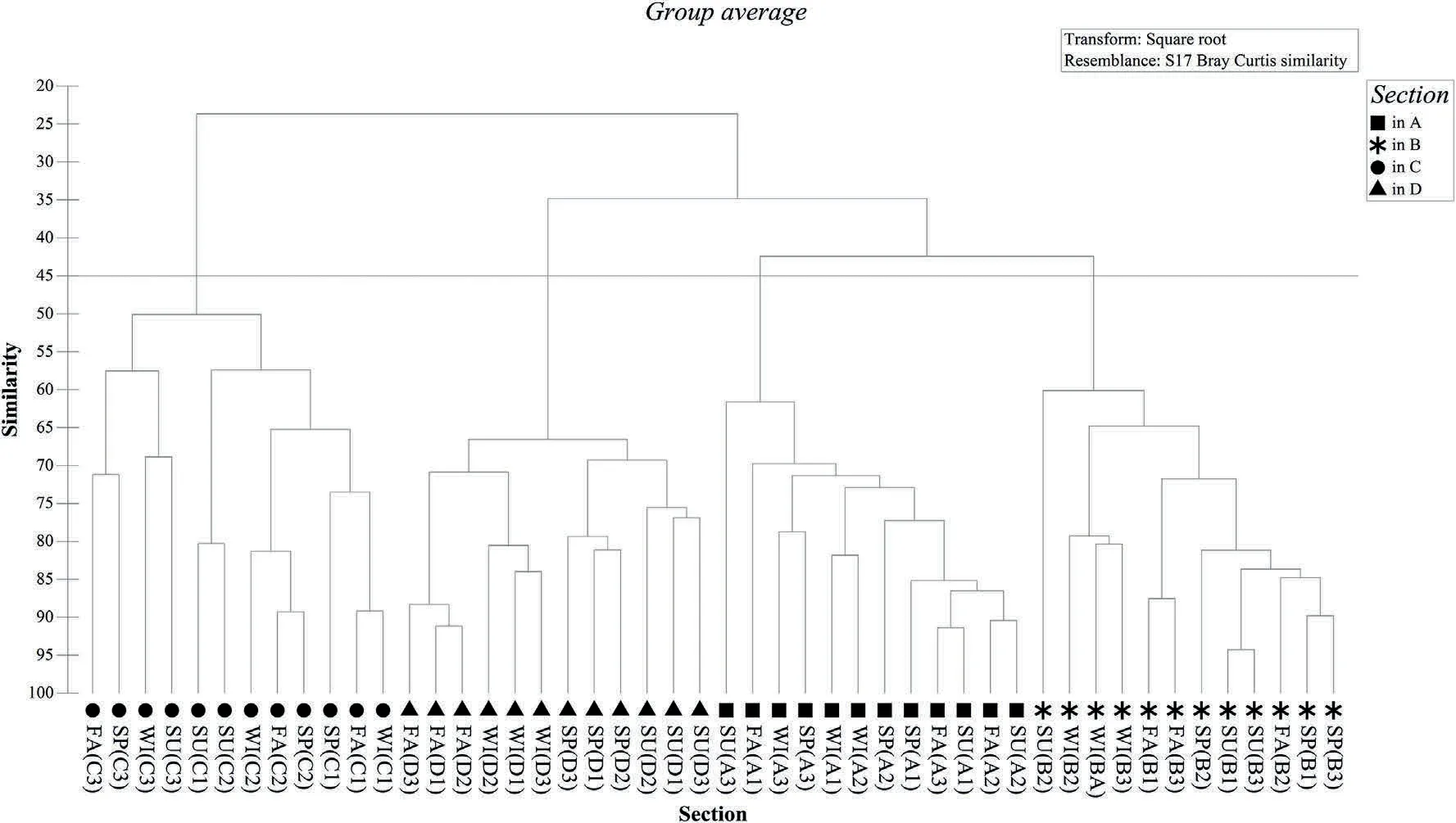
Fig. 5. CLUSTER analysis of assemblages of benthic macroinvertebrates.
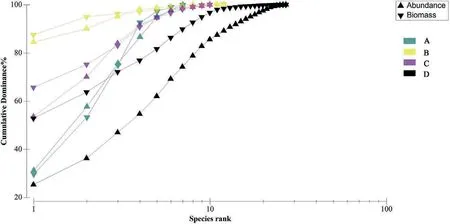
Fig. 6. ABC curves of benthic macroinvertebrates.
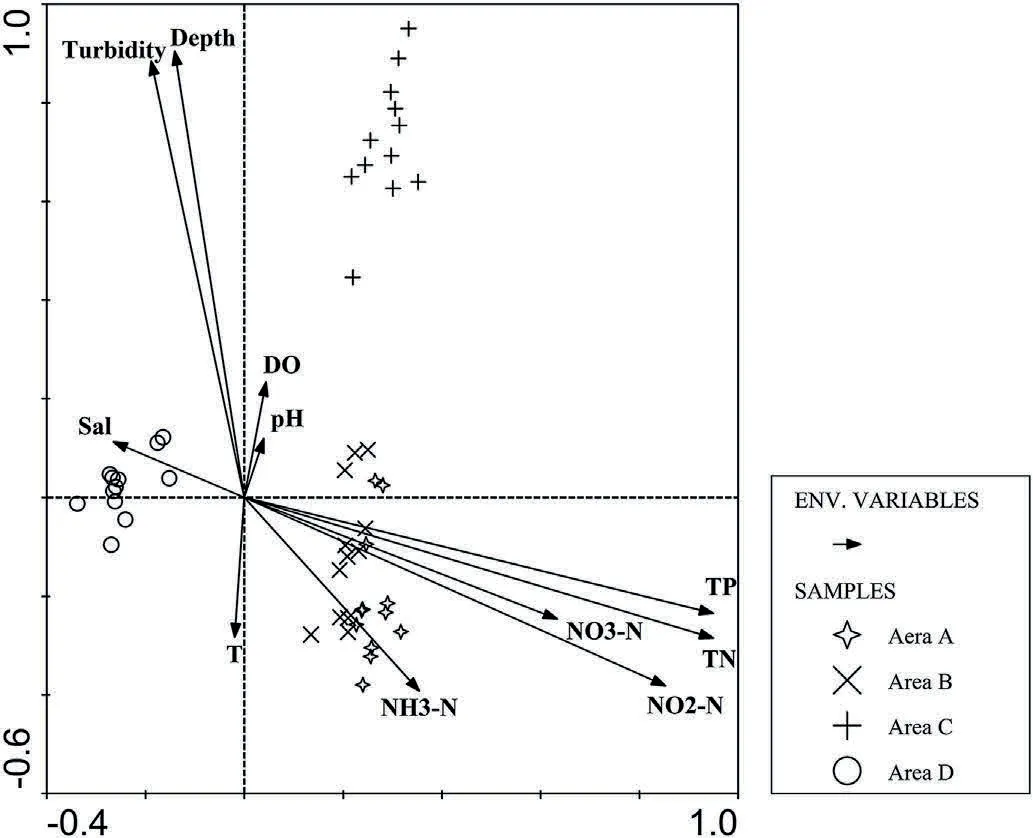
Fig.7. CCA analysis of samples and the following environmental factors:depth;turbidity; Sal, salinity; T, temperature; DO, dissolved oxygen; pH; TP, total phosphorus; TN, total nitrogen; NH4-N, ammonium nitrogen; NO3-N, nitrate nitrogen; NO2-N: Nitrite nitrogen.
For Area B, dike-building accelerated the rate of sedimentation(Yang, Sun, & Huang, 2008), leading to a lower species diversity and unstable community structure and also increased the elevation of the tidal flat, weakening tidal power (Zhu, Feng, Xu, Wang, & Gao, 2014)and providing a relatively stable environment (Gong et al., 2001) that increased the abundance and biomass of benthic macroinvertebrates over other areas. This community structure was subject to seasonal variation. For Area D, high abundance and biomass, no significant seasonal variability, and species diversity indicated stable community characteristic of natural wetlands(Yuan&Lu,2001a,2001b).Area D is located in the tidal-flat wetland of Nature Reserve.
4.2. Environmental factors and sampling areas
Differences in species composition, abundance, and biomass are associated with environmental factors (Naser, 2010). Reclamation changed the sedimentary environment and produced pollutants that influenced the reclamation area.
The content of nitrogen and phosphorus in Areas A and B were higher than in the other two areas, leading to the enhanced growth of salt-marsh vegetation, such as Scirpus mariqueter, especially in Area B.The vegetation contributed to the stable environment, provided a source of food, and stabilized habitat for invertebrates (Yuan & Lu,2002), making it a key factor in the high abundance and biomass observed. Area C was strongly influenced by water depth and turbidity(Fig. 7) as the region most often covered by water. Construction of the dike disturbed the sedimentary environment(Ryu,Nam,&Park,2014)in relatively deep water, exacerbating the turbidity in water with tidal disturbance. This led to an unstable sedimentary environment, decreasing the food available for some benthic macroinvertebrates, such as crabs, and causing a decline in numbers in Area B of taxa such as I.deschampsi.For the same reason,this environment was not conducive to productivity of some Mollusca, such as S. constricta, and some Arthropoda, such as Chiromantes dehaani and I. deschampsi (Zhu, 2004).Essink (1999) suggested that reclamation leads to an increase in water turbidity, decreasing the feeding ability of benthic macroinvertebrates and,therefore,their abundance and biomass.Unlike Areas A,B,and C,macroinvertebrate abundance and biomass were positively correlated with salinity in Area D,which is closer to the fully-marine environment than the others.Higher diversity,richness,and evenness were found in Area D,possibly due to its proximity to the Jiuduansha Nature Reserve,a wetland recently formed during the development of the Yangtze River estuary tidal flat. It was not affected by human disturbance, had rich biological resources,and was maintained in a natural state(Shen,Zhou,Zhang,Wu,&Yang,2006;Song,Yuan,&Zuo,2001;Tang&Lu,2003).
5. Conclusions
Reclamation engineering has changed the tidal flat habitat with varying degrees of negative impact on the community structure of benthic macroinvertebrates, but a significant change from the natural tidal flat. The distributional characteristics of benthic macroinvertebrates in a blowing-sand reclamation area (Area A), a dikebuilding silting area (Area B), an out-of-siltation area (Area C), and a natural tidal flat (Area D) were different from each other, which also indicated different ways that reclamation has on the community structure and diversity of benthic macroinvertebrates. The diversity index increased slightly in the order: Area B <Area C <Area A <Area D. A higher average annual abundance of benthic macroinvertebrates was found at Area B than in Area D, Area A, and Area C,and the biomass in Area C was lower than in the other areas.Reclamation raised the altitude of tidal flats,weakening the tidal power and changing the physical and chemical parameters of the water,which were the key factors that led to the community structure difference of benthic macroinvertebrates in different areas.
Author contributions
Conceived and designed the experiments: JZX and JQY. Performed the experiments: JQY. Analyzed the data: JZX and JQY. Contributed reagents/materials/analysis tools:JZX and HXW.Wrote the paper:JQY,QW and RBA.
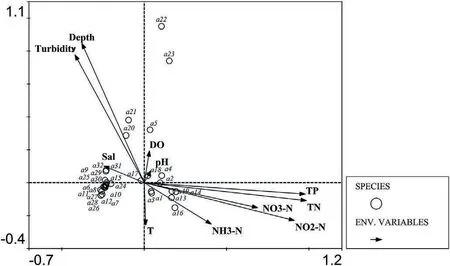
Fig. 8. CCA analysis of macroinvertebrates and environmental factors
Funding
This work was supported by 1. the “Natural Science Fund” of Shanghai (15ZR1420900), Shanghai China; 2. the Public Science and Technology Research Fund of Ocean (201305027-3), Shanghai, China;3.the Fishery Resources Restoration Project of Siltation Zone Outside of Pudong Airport,Shanghai,China.JZX received partial support from the Florida Institute of Technology during the writing of this paper. The funders had no role in study design, data collection and analysis, decision to publish, or preparation of the manuscript.
 Aquaculture and Fisheries2019年5期
Aquaculture and Fisheries2019年5期
- Aquaculture and Fisheries的其它文章
- Management of China's capture fisheries: Review and prospect
- Vulnerability of inland and coastal aquaculture to climate change:Evidence from a developing country
- Biological manipulation of eutrophication in West Yangchen Lake
- Changes in the phytoplankton community structure of the Backshore Wetland of Expo Garden, Shanghai from 2009 to 2010
- Tilapia processing waste silage (TPWS): An alternative ingredient for Litopenaeus vannamei(Boone,1931)diets in biofloc and clear-water systems
